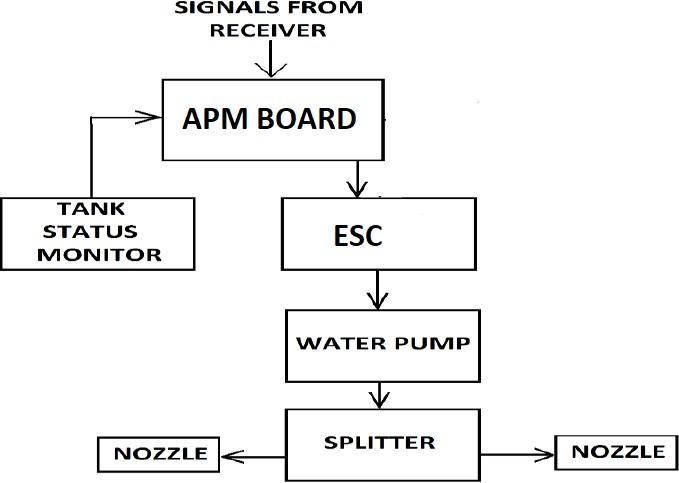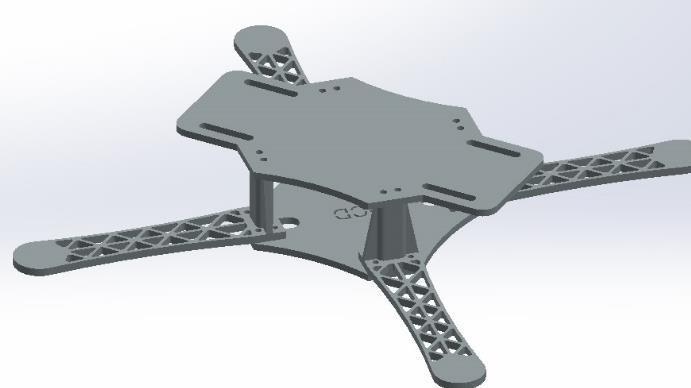International Research Journal of Engineering and Technology (IRJET) e ISSN:2395 0056

Volume: 09 Issue: 06 | Jun 2022 www.irjet.net p-ISSN:2395-0072
DESIGN AND ANALYSIS OF MULTITASKING AGRICULTURAL DRONE
1-5UG student Vishwakarma Institute of Technology, Pune 6Assistant Professor, Mechanical Engineering Department, Vishwakarma Institute of Technology, Pune, Maharashtra, India
***
Abstract Quadcopters are unmanned Ariel Vehicle (UAV), generally small helicopter that is lifted and propelled by four rotors. Initially they were used as toys, later they gained importance and recent research on multi copters have received growing attention for military, agriculture, photography, surveillance, news, sports, search/rescue missions and much more. The widespread use of unmanned vehicles and its growing applications in various domains can be attributed to their ability to operate in inaccessible areas, thus decreasing the human loss in major accidents, and making access easy to dangerous conditions. We have proposed an idea about how quadcopter can be used for the agricultural applications. The target of this paper is to explain briefly to prepare a quadcopter so that it could be used in agricultural and can help our society, we have also explained working and manufacturing of quadcopters in detail so that it can help in agricultural domain to increase the efficiency and productivity.
Keywords UnmannedArielVehicle(UAV),Vertical Take off and Landing (VTOL), remotely piloted vehicles (RPV), Clockwise(CW),Counter clockwise(CCW).
1. INTRODUCTION
According to a survey conducted by WHO (world health organization)itisestimatedthateveryyearabout3million workersareaffectedbypoisoningfrompesticidesofwhich 18000die.Thisprojectaimstoovercometheill effectofthe pesticidesonhumanbeingsandalsousetospraypesticides over large area in short intervals of time compare to conventionalsprayingbyusingautomaticfertilizersprayer. This device is basically combination of a spraying mechanismsonaquadcopterframe.Thismodelisusedto spraythepesticidescontenttotheareasthatcannoteasily accessiblebyhumans.Theuniversalsprayersystemusesto sprayliquidaswellassolidcontentswhicharedonebythe universalnozzle.
1.1 Types Of Drones
DependingontheTypeofAerialPlatform
Theclassificationofdrones basedonhow they manageto stayupintheair:
Multi Rotor:
These drones have multiple motors on their bodies. They are popular for aerial photography and surveillance becausetheycanstayintheairforlongperiodsoftimein oneplace.
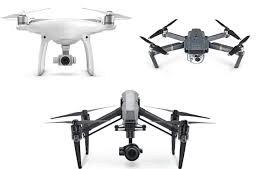
Fig. 1 MultiRotorDrone
FixedWing:
Other major drone designs consist of fixed wing models where the drone mimics the engineering style of an airplane.Thesedronescan'tstayinoneplace,buttheywill glidealongadesignatedpath,aslongaspowerallows.
Fig. 2 FixedWingDrone
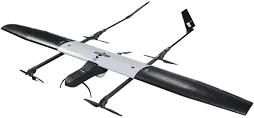
SingleRotor:
Asinglerotorisusedtoflythedrone,andanothersmall rotornearthetailcontrolsthedirection.Thesedrones,also knownasRChelicopters,aremoreefficientthanmultirotor drones. They can fly higher, stay in one position without rotating, and often use gas instead of electricity to power theirbodies.
Adnan Inamdar1, Vedat Aher2, Sonal Dangare3, Devyani Deshmukh4, Saurabh Solanke5 , Dr. Laxmikant D Mangate6Fig. 3 SingleRotorDrone
A quadcopter is a device that is a concentrated combination of electrical equipment and mechanical engineering,primarilybasedonaviationprinciples.Tokeep theplaneflying,therearefourmajorforcesthatworkforthe planetofly.Twooftheseforcesaregeneratedbytherelative motion of air with respect to the aircraft. The first is the elevator. This force is directed upwards and acts perpendicular to the displacement of the plane. Thanks to this power, the plane is kept in the air. The second is resistance. It acts in the opposite direction to the displacementoftheplane.Thisisduetotherefractioneffect ofairontheaircraft,whichhinderstheaircraftfrommoving forward.
Liftanddragarecalledaerodynamicforcesbecausethey resultfromtheactionofairduetothedisplacementofthe aircraft.Gravity,theweightoftheaircraft,counteractslift. The balance between lift and weight tends to keep the aircraft at a constant altitude. To ensure that the aircraft keepsmovingforward,aforcethatoffsetswhatisknownas dragmustbeprovided.Thisforceiscalledthrust.
Thrust is generated by the engine, which is the propulsionsystemoftheaircraft.
2.2 Movement Mechanism
A quadcopter can be described as a small vehicle with fourpropellersmountedonarotorlocatedinahorizontal frame. This fixed pitch rotor target is used to control the movementofthevehicle.Thespeedsofthesefourrotorsare independentofeachother.Independentpitch,rollandyaw posturesalloweasycontrolofthevehicle.Thefigureshows thepitch,roll,andyawmovementsofaquadcopter.
1. Yaw motion (ψ): Rotation around the vertical axis is calledyaw.Theruddercontrolstheyaw(leftandright).
2.Tiltmovement(ө):Rotationaroundtheleftandrightaxes is called tilt. H. Vertical movement around the horizontal axis.Theelevatorcontrolsthepitch.

3.Rollmotion(Ф):Rotationaroundtheaxisiscalledroll.H. Ratherthantiltingaroundtheaxis.Aileronscontroltheroll axes(leftandright).
4.Takeoffandlandingmovementmechanism:Takeoffisthe movement of a quadcopter to take off from the ground to the hovering position, where the landing position is the oppositeofthetakeoffposition.
6. Left and right motion: For left and right motion, it can controlbychangingtheyawangleofQuadcopter.Yawangle can control by increasing (decreasing) counter clockwise rotorsspeedwhiledecreasing(increasing)clockwiserotor speed. Hovering or static position the hovering or static position of Quadcopter is done by two pairs of rotors are rotating in clockwise and counter clockwise respectively with same speed. If the two rotors are rotating clockwise and counterclockwise, the total reaction torque is zero, whichputsthequadcopterinthehoveringposition.
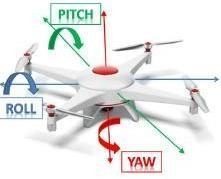
Frame Sizes
Table 1: Frame sizes

Fig. 4 Differenttypesofmotion
FRAMESIZE (WHEELBASE)
PROP SIZE MOTOR kilovolt (kV) 100mm 2inches 1102 1104 6000+ 120mm 3inches 1104 106 4000+ 150mm 180mm 4inches 1306 1408 3000+ 200mm 220mm 5inches 2204 2306 2100 2800 235mm 280mm 6inches 2205 2308 1600 2500 330mm 350mm 7 8inches 2208 2212 1500 1600 450mm 500mm 9 10inches 2212 2216 800 1000
Astaticthrustcalculationisrequiredtoensurethatthe correct propeller and engine are selected. Static thrust is defined as the thrust produced by a propeller that is stationary with respect to the earth. This calculation is especially important for this project, as quadcopter helicopters tend to operate slower than Earth. This low speed performance allows static thrust calculations to be
applied to a wide range of flight conditions. It is also importanttonotethatthefinalstaticthrustcalculationisan estimate,notanactualvalue.
Thefirststepincalculatingstaticthrustistodetermine theoutputinrevolutionsperminutetransmittedfromthe engine to the propellers. Aircraft world.com has compiled empirical data used to calculate horsepower [1] and the formulausedfortheirdatasheetisgiveninEquation1.
Power=PropConst*rpmPowerfactor [1]
Here,thehorsepoweriswattsandtheRPM isa thousand. Forexample,a6X4APCpropellerhasapropellerconstantof 0.015andapowerfactorof3.2.Ataspeedof10,000rpm, thefollowingcalculationresultsareobtained.
Power=0.015×103.2=24W
The next step is to determine the thrust produced by a propeller.Equation2givesthrustbasedontheMomentum Theory.
T=π/4D2ρvᴡΔv [2]
Where, T=thrust[N]
D=PropellerDiameter[m]
v=velocityofairatthepropeller[m/s]
Δv=velocityofairacceleratedbypropeller[m/s]
ρ=densityofair[1.225kg/m3]
A commonly used rule is that velocity of the air at the propeller is v=½Δv of the total change in air velocity: Therefore,andequation3isderived.
T=π/8D2ρ(Δv)2 [3]
Equation4givesthepowerthatisabsorbedbythepropeller from the motor. Equation 5 shows the result of solving equation4forΔvandsubstitutingitintoequation3.Indoing so,Δviseliminatedandtorquecanbecalculated.
P=(TΔv)/2=>Δv=2P/T [4]
T=[(π/2)D2ρP2]1/3 [5]
Finally,itisadvantageoustoexpresstheresultsofequation 5intermsofmass.Newton’sLaw,F=ma,isusedtoobtain equation6.
m=([(π/2)D2ρP2]1/3)/g [6]
where,g=9.81m/s2Solvingformassisusefulforquadrotor helicoptersbecauseitcanbedirectlyrelatedtothemassof the aircraft. In particular, a thrust (mass) that equals the massoftheaircraftisneededforhovering.
2.5 DC Motor
This section provides an overview of DC motors and the importance of DC motor performance in relation to the quadcopter'slevitationcapability.BrushlessDCmotorsare themostcommonlyusedmotorsinRChobbiesbecauseof theiravailability,price,andperformance.
Fig. 5 Generalizedtorquevs.speedcurveofaDCmotor withaconstantappliedvoltage
Maximum torque can be reached when the engine is fully braked and no torque is generated when the engine is runningatmaximumspeed.DCmotorsperformbestwhen producing the most mechanical power. Power is the productoftorqueandvelocitygiveninEquation7.
Power=Torque*RotationalSpeed [7]

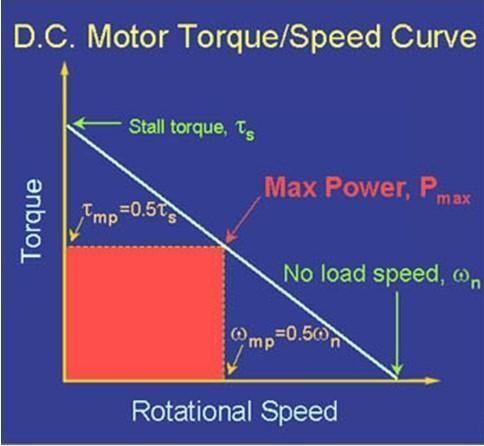
To determine the maximum output of an engine, you only needtodeterminethespeedatwhichthemaximumoutput occurs.Figure5.1showsthatmaximumpowerisobtained at torque and speed equal to half the maximum motor power at constant voltage. Maximum power is important becauseitisdesirabletomatchtheoptimumpowerrange of the engine to the most common flight conditions of the aircraft. In this case, the most common type of flight for quadcopter helicopters is hover flight. Hovering occurs when the propeller / motorset produces thrust (mass) equaltotheweightoftheaircraft.Hoveringshouldbedone at 50% of the motor's maximum capacity. This is directly related to the equivalent of half the battery voltage. Since the DC motor is rated at kV (rpm / v), the speed at which maximum power is achieved is calculated by multiplying themotor'skVbyhalfthebatteryvoltageanddividingthe resultbytwo.
rpmmaxPower =(kV*0.5*Battery_Volts)/2 [8]
International
Volume: 09 Issue: 06 | Jun 2022 www.irjet.net p-ISSN:2395-0072

The desired resulting speed occurs at 1/4 of the motor's maximum speedat full voltage.RPMs for this purpose are used in the Propeller and Engine Selection section of this report. However, before choosing the right propeller and engine,youneedtoestimatethemassoftheaircraft.
2.6 SELECTION OF COMPONENTS
2.7 Propeller and Motor
Now that a method for calculating static thrust, an understanding of DC motor power, and an estimated aircraftweighthasbeenestablished,theproperpropellers andmotorscanbedetermined.
Table 2: Idealmotorrpmfrommotorspecifications
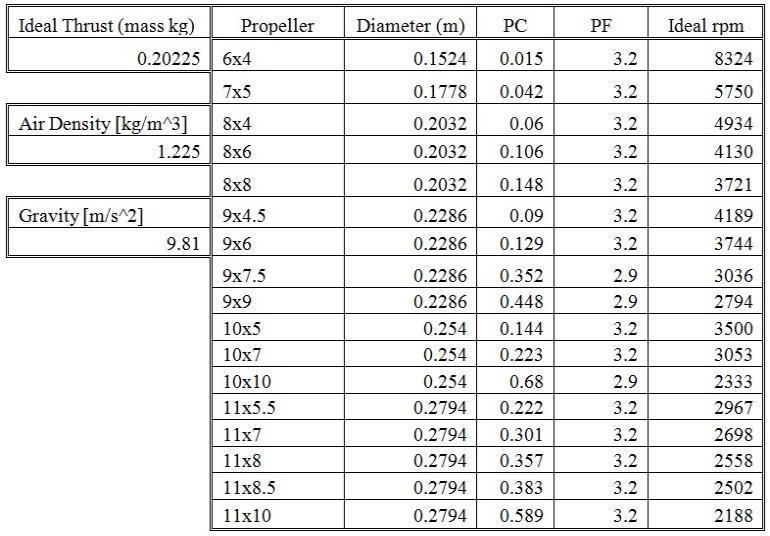
The mass entered in Equation 9 is the estimated mass of 809gdividedby4becausetherearefourengine/propeller setsthatcontributetothelift.Table3showstheresultsof Equation9forvariousAPCEpropellers.
Motor kV(rpm/v) Max rpm
Ideal rpm 2822/14 BrushlessOut runner1450 kV
1450 16095 4024 TURNIGY 220414T19g Outrunner
1450 16095 4024 TURNIGY1811 Brushless IndoorMotor 1500kV
1500 16650 4163 TURNIGY2730 Brushless Motor1500kV
1500 16650 4163 HobbyKing Donkey ST2004 1550 kV Brushless Motor
1550 17205 4301 AP19 Brushless Motor
Fig 6: Idealmotorrpmfrommomentum theory calculations
2.7.1 Battery and Flight Time
Themost common battery typeused in thehobby market todayisLithiumPolymer(LiPo),whichwasselectedforthis project.ThepopularityofLiPobatteriesisduetotheirlarge capacity,lightweightandexcellentdischargecapacity.Here issomegeneralinformationaboutLiPobatteries:
• Each cell of the LiPo battery is rated at 3.6 V, and when eachcellreaches3.0V,itisfullydischargedandthebattery usually contains 1 to 3 cells. (Note: If the LiPo battery is dischargedbelow3V/cell,itwillnotbeabletobecharged.)
• Current is represented by C and corresponds to the maximum discharge rate of the battery. For example, a 1C battery can handle a current that takes an hour to fully discharge,anda2Cbatterycandischargein30minutes.
1600 17760 4440
1580 17538 4385 C2024 Micro BrushlessOut runner1600 kV(17kg)
Thenextstepistodeterminetheidealrpmofthepropeller. IdealrpmforapropellerisfoundbycombiningEquations1 and 6 and solving for rpm. Equation 9 shows the result of thismathematicalmanipulation. 1
• Battery capacity is expressed in milliamp hours (mAh). Flight time will be analyzed to determine the appropriate battery. Flight time, which is directly proportional to batterycapacity,canbefoundbydividing batterycapacity bytheamountofampsbeingdrawnfromthebattery.
FlightTime=BatteryCapacity/amps… [10] Accordingtoourproject, FlightTime=11.1V/2.1amp=5.2min
Table 4: Flight time w.r.t battery capacity and discharge 1 3 3 �� rate 2 2ω
Capacity [mAh]
=PowerFactorfromAircraft world.com α=PowerCoefficientfromAircraft world.com D=Diameter[m] p=AirDensity[1.225kg/m^3] m=Mass[kg] g=Gravity[9.81m/s^2]
Flighttimeat 100%Discharge Rate[min]
Flighttimeat 50%Discharge Rate[min] 1000 1.5 3 1200 1.8 3.6 1400 2.1 4.2 1600 2.4 4.8 1800 2.7 5.4 2000 3 6 2200 3.3 6.6
2400 3.6 7.2 2600 3.9 7.8
2.8 COMPONENTS
2.8.1 Chassis
A drone skeleton to which all components are connected. The chassis design is a compromise between strength (especially when extra weight like a camera is attached) and extra weight that requires a longerpropellerandamorepowerfulenginetolift.Thebase of the drone, made of strong fibers with four arms. Each armconsistsofaBLDCmotorthathelpsthedronefly.
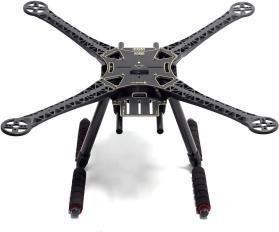
rotation improves flight performance, but requires more power from the battery, which reduces flight time.
BLDC Motor: This is a high-performance motor with excellentefficiency.Themotorisratedatkilovolts,and thehigherthekVrating,thefasterthemotorwillrotate at a constant voltage. The purpose of the engine is to rotate the propeller. Brushless DC motors provide the thrustneededtomovethevehicleforward.Iamusing a 1000kV motor. Propeller Two types of propeller pushersandpullersareused.Pusher:Thepushergives thrustwhenturnedclockwise.Puller:Thepullergives thrust when turned counterclockwise. Propellers are available in a variety of diameters and pitches (tilt effect). The larger the diameter and pitch, the greater the thrust the propeller can generate. It also requires more force to propel it, but it will be able to lift more weight. Small or medium propellers when using high speed(revolutionsperminute)motors.Ifyouusealow speed motor, you can use a large propeller as it can cause problems if the small propeller cannot lift the quadcopteratlowspeeds.
2.8.2
Fig. 7 Chassis
Propellers
Thismainlyaffectstheloadthataquadcoptercancarry, thespeedatwhichitcanfly,andthespeedatwhichit canbemaneuvered.Youcanchangethelength.Longer propellers can provide more lift with lower RPM, but sloweracceleration/deceleration.Shortpropellersare more maneuverable because they can change speeds faster,buttheyrequirehigherRPMtoachievethesame performance as long blades. This leads to excessive engine stress and thus shortens engine life. A more aggressivetiltallowsforfastermovements,butreduces hoverefficiency.
Thesegeneratethrustandtorquethatallowthedrone tofly.Theupwardthrustgeneratedbythepropelleris usuallymeasuredinpoundsorgrams.Inorderforthe drone to stay on the hover, the upward thrust must match the weight of the drone. Thrust-to-weight ratio TWR (thrust divided by weight) indicates how much thrustthedroneproducesforthatweight.

Fig. 8 Propellers
2.8.3
Motors
Oneforeachpropeller,theratingofthedronemotoris in "Kv" units. This is the number of revolutions per minutethatcanbeachievedwhenavoltageof1voltis applied to the motor with no load. Faster motor
Fig. 9 Motor
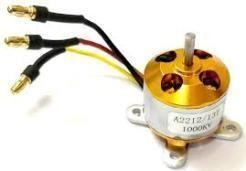

2.8.4 Electronic Speed Controller (ESC)
The electronic speed controller controls the speed of the motor and tells the motor the speed of rotation at any point in time. The quadcopter requires four ESCs, one connected to each motor. The ESC is then connected directly to the battery using either a wire harness or a switchboard. The Electronic Speed Controller(ESC)isanelectroniccircuitthatchangesthe speedanddirectionofabrushlessmotorandcanactas a dynamic brake. The maximum current flowing throughtheESCis30 40amps.
Fig.
10 ESC
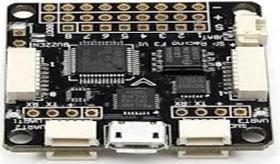
2.8.5 Flight Controller
The onboard computer which interprets incoming
signals sent from the pilot and sends corresponding inputs to the ESC to control thequadcopter.
www.irjet.net p-ISSN:2395-0072

Camera
2.8.6 Transmitter and Receiver
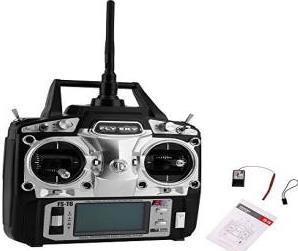
Transmitter uses radio signals to transmit commands wirelessly via a set radio frequency over to the radio receiver, which is connected to drone being remotely controlled
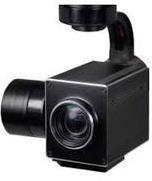
Helpstoknowthecrophealththroughvisualsandcan alsocaptureimages which will help farmer to analyze crophealtheasily.
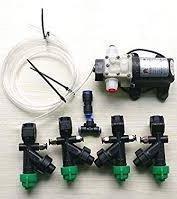
Fig. 13 Camera
2.8.8 Water Pump
Fig. 11 Transmitterandreceiver
2.8.7
Battery
The battery is the power source that powers all other systemsinthedrone.Batterychargershelpchargethe battery.Lithiumpolymerbatteriesarecommonlyused because of their high power density and rechargeability.
This will suck pesticides from container and will transferittothesprayersthroughthewaterhosesi.e. hoses are generally transparent pipes used in transferring the pesticides from the container to the sprinkler.
2.8.9 Container
Storethepesticidesinliquidform.Generally,astorage for pesticides hanged below the drone’s base. From here the pump suck and transfer the pesticides to the sprinklerwhichareplacedattheendofeverywings.
Fig. 12 Battery
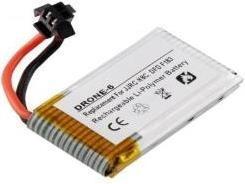
The most common battery type used in the hobby market today is Lithium Polymer (LiPo), which was selected for this project. The popularity of LiPo batteries comes from their high capacity, light weight andexcellentdischargecapacity.Hereissomegeneral informationaboutLiPobatteries:
•EachcelloftheLiPobatteryisratedat3.6V,andwhen each cell reaches 3.0 V, it is fully discharged and the batteryusuallycontains1 to3cells.(Note:IftheLiPo batteryisdischargedbelow3V/cell,itwillnotbeable tobecharged.)
• Current is represented by C and corresponds to the maximumdischargerateofthebattery.Forexample,a 1C battery can handle a current that takes an hour to fully discharge, and a 2C battery can discharge in 30 minutes.
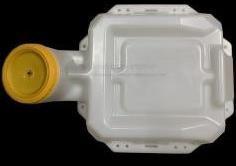
• Battery capacity is expressed in milliamp hours (mAh).
Fig. 14 Container
2.8.10 Sprinkler
Sprinkle pesticides to the crops. Placed in the end of every wings, below the BLDC motor. Sprinklers sprinklethepesticidesprovidedbythepumpfromthe container.
Fig. 15 Sprinkler


